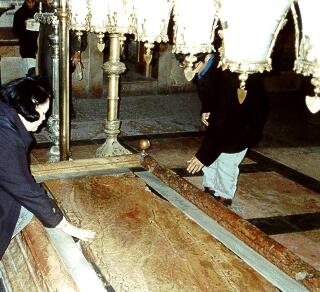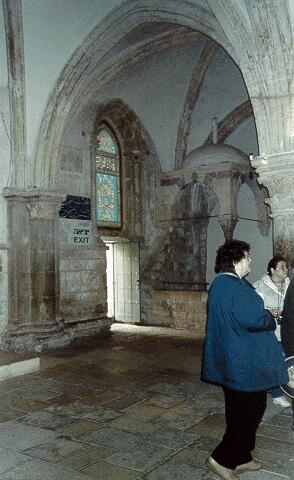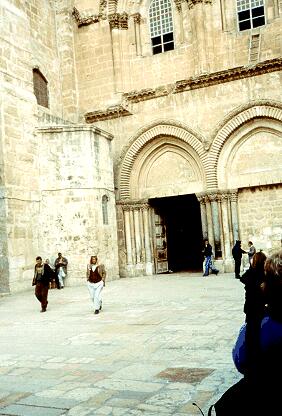 |
|
|
|
|
|
|
|
|
|
|
|
|
|
|
|
|
|
|
|
|
|
|
|
|
|
|
|
|
|
|
|
|
|
|
|
|
|
|
|
|
|
|
|
|
|
|
|
|
|
|
|
|
|
|
|
|
|
DAY 2 |
|
|
|
 |
|
|
|
|
Friday, 8 January |
|
|
|
|
|
Unable to travel to east Jerusalem because it was a Friday in Ramadan, we headed to Mount Zion instead, and made our first stop at the building which houses both the Upper Room and the tomb of David. The Upper Room, at one time a medieval chapel, at another a Moslem prayer room, remains the place of the Last Supper, the place of Pentecost, the place where the earliest Christians continued to meet to celebrate the very Eucharist instituted there, at that last Passover shared by Jesus and His Apostles. The lower section of the building contains a chamber where we found a tomb draped in elaborately decorated black cloth. To the left of the tomb stands a beautifully carved chair of Elijah (used in the ritual of circumcision); a sign hanging on the right proclaims "David, King of Israel, is alive and lives still." |
|
|
|
|
|
The slab of stone upon which Jesus' body was laid after being removed from the Cross. |
|
|
|
|
|
|
|
|
 |
|
|
|
Making our way further into the church, we came to Jesus' tomb. The once plain stone has been elaborately decorated, and pilgrims wait their turn to descend low steps into the empty tomb under the watchful gaze of a rather tyrannical monk. Only three people at a time can enter and kneel in the inner chamber to touch the marble ledge which served as the burial place of the Son of God. Lit by flickering candles and perfumed by incense, the tomb was dim, but it held no sense of death, for the tremendous and simple fact that it is empty. Above the marble ledge on a band of gold are etched the Latin words "Non est hic. Ecce locus ubi posuerunt eum"-- "He is not here. Behold the place where they have laid Him". |
|
|
|
|
 |
|
|
|
The Upper Room |
|
|
|
|
|
|
|
|
|
Inside the empty tomb |
|
|
|
|
|
We were privileged to be able to have Mass in a chapel at the Church of the Holy Sepulchre with Fr. Greg as the celebrant. Back outside, an Arab happily changed money for us and, after a mad dash through the sukh, we found a sidewalk cafe where we enjoyed falafel on pita and coffee (Turkish for me, naturally). As we ate, the azam sounded, calling Moslems to prayer; at noon, church bells rang the Angelus. |
|
|
 |
|
|
|
|
|
|
Upon returning to the hotel, we attended a lecture by Rabbi Henri Noach on the nature and observance of Shabbat, and then boarded a bus for the Great Synagogue. We disembarked a short distance from it and walked the rest of the way (to avoid giving scandal-- driving is prohibited on Shabbat); inside the men entered the lower level and the women ascended to the balcony. The service lasted two hours and consisted primarily of chants and prayers sung by a choir. |
|
|
The tomb of
King David |
|
|
|
|
|
|
|
|
|
|
At the hotel, the restaurant was full of families spending the night for Shabbat. They sang, prayed, and talked, filling the room with that most rare and delightful sense of festive solemnity. After dinner, most of us walked to a cafe called Cinematique. It is, apparantly, a revolutionary place (read "Damascus Gate"), which fact quickly increased its prestige in my eyes. Disappointed that they no longer carried the drinks remembered so fondly by one of our professors, we sipped wine and told stories until it was time to make our way home. |
|
|
|
|
|
 |
|
|
 |
|
|
|
 |
|
|
|
|
We walked for a while through the Jewish Quarter, passing along the way children playing in a yeshiva schoolyard; eventually we went through the Mount Zion Gate, dodging speeding cars as they tried to squeeze through impossibly narrow turns, crowds of people, and the occassional donkey and cart. The Mount Zion Gate was the dividing line between the newly formed State of Israel and Jordan in 1948; the place where we stood was once filled with barbed wire, and bullet holes are still visible in the stone facade. |
|
|
|
|
|
|
|
|
|
|
|
|
|
|
|
|
|
|
|
|
|
Continuing on our way, we walked along the "cordo"-- the main street transecting the city, all of which is, by law, built from the same stone: limestone quarried from Jerusalem. The overall effect is one of striking majesty, although we later discovered that the limestone pavements are treacherously slick in the rain. We descended to what used to be street level in Byzantium (about 30 feet below current street level), and following the cordo passed through a group of orthodox students and their teacher. The girls sat in the open air, on rocks, huddled over their notebooks; they and their professor kindly allowed us to interrupt the lesson to view an ancient mosaic map on the wall. |
|
|
|
Walking a little further, we looked up and were surprised to see a mosque. How did a mosque come to be built in the middle of the Jewish Quarter? It seems there once lived a woman who had a less than attractive son. The matchmaker could only find a less than attractive woman for him, but his mother insisted that her son deserved the best. When the matchmaker was unable to produce it, she reasoned that since no one wanted her son, she would no longer want them, and promptly converted to Islam. As a final touch, she built a mosque on her own property, so that everyone going to the synagogue would have to see it a they passed by. |
|
|
|
We walked next to the Church of the Holy Sepulchre. Owned by two Muslim families, inhabited by Greek Orthodox monks, and fought over for generations, this church is built on the site of the crucifixion. Different Christian Churches battled over it so fiercely and for so long that they finally decided to call a truce, and make no changes unless all parties agreed. Consequently, there stands a ladder leaning against a wall on a balcony which has remained on that spot for 100 years. Inside, we visited the altar which marks the site of the crucifixion; beneath the altar a silver rimmed hole in the church floor allowed us to reach through and touch the ground upon which stood the Cross of Jesus. Nearby, a marble-like slab is venerated as the place where His body was laid after being removed from the Cross. |
|
|
|
 |
|
|
|
The Church of the Holy Sepulchre, Jerusalem.
Note the ladder on the balcony under the window in the upper right-hand corner. |
|
|
|
|
|
 |
|
|
The altar built over the place where Jesus' Cross stood. |
|
|
|
|
|
|
 |
|
|
|
Scroll to the right to continue... |
|









